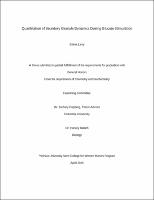Please use this identifier to cite or link to this item:
https://hdl.handle.net/20.500.12202/4069Full metadata record
| DC Field | Value | Language |
|---|---|---|
| dc.contributor.author | Levy, Elana | - |
| dc.date.accessioned | 2018-11-05T21:11:05Z | - |
| dc.date.available | 2018-11-05T21:11:05Z | - |
| dc.date.issued | 2015-04 | - |
| dc.identifier.uri | https://hdl.handle.net/20.500.12202/4069 | - |
| dc.identifier.uri | https://ezproxy.yu.edu/login?url=https://repository.yu.edu/handle/20.500.12202/4069 | |
| dc.description | The file is restricted for YU community access only. | - |
| dc.description.abstract | In humans, insulin release is necessary to the regulation of the metabolism and is triggered by the presence of glucose in the bloodstream. Insulin release originates from beta cells of the islets of Langerhans in the pancreas, where it is stored in approximately 10,000 secretory granules per cell12 . Its release is triggered by the presence of excess glucose in the blood, which would be toxic if not processed promptly. A loss of insulin content or mechanistic control of insulin release can result in various metabolic conditions including, classically, diabetes mellitus3 . After stimulation and synthesis, insulin must be packaged into granules for exocytotic release. These secretory granules are instrumental for the efficient and effective release of insulin into the bloodstream. Secretagogue stimulation results in the transcription, translation, and release of insulin through these transport vesicles. This secretory regulation is critical in ensuring proper control over diverse signaling events, including cell metabolism, growth, and differentiation4 . While long-studied, no formal consensus exists regarding the precise mechanisms responsible for packaging of insulin into granules, how these loaded granules are transported to the cell surface, and then their release of contents into the bloodstream during periods of prolonged cell stimulation56 . Particularly in the case of insulin secretion, to date, the exact mechanisms remain poorly characterized and controversial. The central question revolves around the kinetics of insulin granule recruitment and release upon reaching the release zone. | en_US |
| dc.language.iso | en_US | en_US |
| dc.publisher | Stern College for Women | en_US |
| dc.rights | Attribution-NonCommercial-NoDerivs 3.0 United States | * |
| dc.rights.uri | http://creativecommons.org/licenses/by-nc-nd/3.0/us/ | * |
| dc.subject | Insulin --Mechanism of action --Research. | en_US |
| dc.subject | Glucose --Mechanism of action --Research. | en_US |
| dc.subject | Cryomicroscopy. | en_US |
| dc.subject | Cytoplasmic granules --Research. | en_US |
| dc.subject | Granular flow --Research. | en_US |
| dc.title | Quantitation of Secretory Granule Dynamics During Glucose Stimulation | en_US |
| dc.type | Thesis | en_US |
| Appears in Collections: | S. Daniel Abraham Honors Student Theses | |
Files in This Item:
| File | Description | Size | Format | |
|---|---|---|---|---|
| Elana-Levy.pdf Restricted Access | 524.81 kB | Adobe PDF |  View/Open |
This item is licensed under a Creative Commons License

